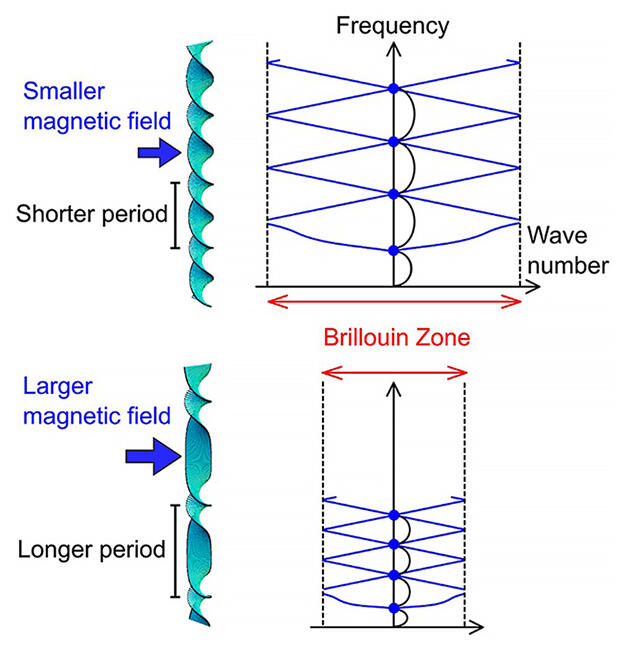A research team led by JSPS Research Fellow (PD) Yusuke Shimamoto, and Professor Yoshihiko Togawa of the Graduate School of Engineering at Osaka Metropolitan University and Professor Junichiro Kishine at the Open University of Japan has succeeded in experimentally observing the collective resonance motion in the microwave region of magnetic superstructures called chiral magnetic soliton lattices (CSLs) appearing in chiral magnetic crystals. Theoretically, its resonance frequency was found to modulate in a broad band up to the sub terahertz band, even in small magnetic fields. The characteristics of frequency tunability in a wide bandwidth are expected to be used in the research and development of the next communication technology beyond 5G. The team's findings were published in Physical Review Letters.

Provided by OMU
In Japan, commercialization of the 5th generation mobile communication system (5G), which uses frequency bands ranging from several gigahertz to several tens of gigahertz, is underway. In 2020, the Ministry of Internal Affairs and Communications began formulating a strategy to use frequency bands above 100 gigahertz as Beyond5G, the next generation of 5G. It will be necessary to significantly expand the frequency bandwidth to further increase the capacity and speed of wireless communications.
Magnetic materials that resonantly absorb microwaves are used in bandpass filters for high-frequency measurement devices and radio telescopes. They are indispensable for the development of high-frequency technology because of the property that the frequency at which magnetic resonance occurs varies with the applied magnetic field strength. However, the frequencies of existing magnetic materials are limited to a few gigahertz to 70 gigahertz, and the development of next-generation communication technology requires the use of completely new physical phenomena.
The research group focused on CSLs, which are expected to be used as a next-generation information medium because of their particle and wave properties. They studied their high-frequency characteristics using microwave spectroscopy and succeeded for the first time in the world in observing the broadband collective resonance motion exhibited by CSLs. This phenomenon is caused by the excellent structural controllability of CSLs, and they will be a new principle for modulating the frequency of magnetic resonance in a wide bandwidth down to the sub terahertz band. This broadband and frequency tunable characteristic are expected to be employed in the development of next-generation communication technologies beyond 5G.
"The detection of collective resonance motion in chiral magnetic soliton lattices has been my goal since I started working on chiral magnetism research," explains Professor Togawa. "Our experiment was a success at last. The properties we obtained are beyond our expectations and are excellent. We will continue our research with the aim of deploying it in next-generation communication technologies."
This article has been translated by JST with permission from The Science News Ltd.(https://sci-news.co.jp/). Unauthorized reproduction of the article and photographs is prohibited.




